Sometimes it feels like robots only exist to be abused, you know? We love them and the window they provide on the human condition, but science fiction is usually pretty mean to them overall. It loves to torment robots (and when we say “robots” we’re really talking about any form of android or A.I. or sentient toaster or what-have-you) with the constant threat of obsolescence or deactivation or destruction. And some of these deaths are just plain gratuitous, leaving us betrayed, bewildered, and otherwise bereaved.
Here are the worst of them.
Data, Star Trek: Nemesis
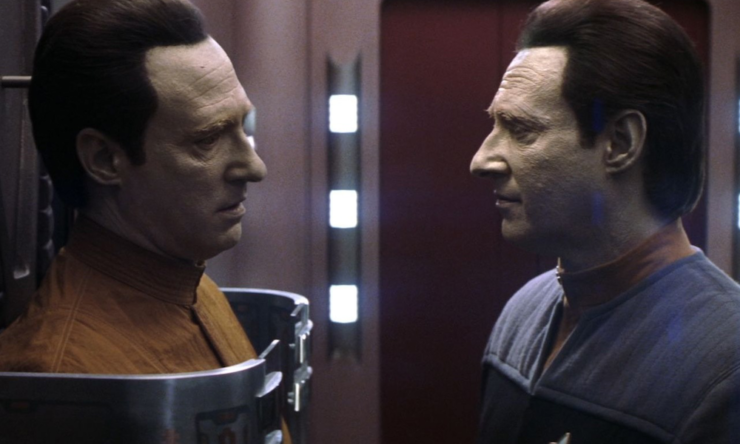
Type of “Robot”: Android
Why Death Was Gratuitous: Look, Nemesis was supposed to be the big bow-out for the Next Gen cast, but it just didn’t work that well. The plot was fuzzy, the villain weirdly contrived, and nothing about the film seemed to truly embody the tone or themes that Next Gen tackled. But perhaps the greatest offense of all was that, in the desire to make the final film feel like an epic sendoff, Data rescued Picard from Shinzon’s ship before sacrificing himself to keep his friends safe. This is already upsetting enough, seeing as the script seems to use Data’s death to make the audience “feel” how important the events of the film are, even when they aren’t well-executed. But then there’s the problem of B-4 to contend with as well.
Nemesis introduces an earlier version of Data named B-4 (GET IT) into the mix, a less advanced model who has none of Data’s experiences. At the end of the film, Picard finds out that Data downloaded engrams of his neural net into B-4 before making his sacrifice play. So Data kinda dies but also doesn’t. B-4 is probably never going to be Data, but he’s there-ish. Which just makes Data’s entire arc in the film seem like a waste and an insult. Either go for it, or don’t. And then please attach it to a better film. —Emmet Asher-Perrin
The Stray, Westworld
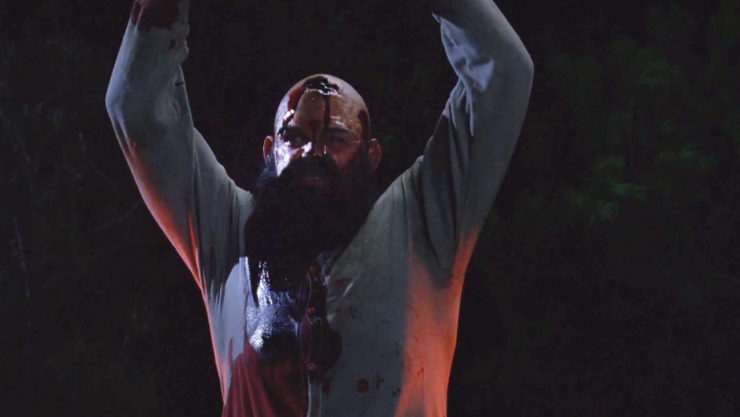
Type of “Robot”: Host, or android
Why Death Was Gratuitous: Really, every death on Westworld stretches the limits of palatability, and the one you choose is probably a better litmus test than most. While I feel for poor Teddy’s 5,000-plus deaths at the hands of Westworld’s trigger-happy clients, what stuck with me was the rare case of host self-harm early in season 1. When Elsie and Stubbs discover a random host who has strayed from his normal narrative loop, he demonstrates that while something is wonky in his circuitry, his programming—do not kill humans—is intact.
Stubbs tries to decapitate him so that they can take his brain back to the lab for analysis, so of course the host’s survival instinct kicks in and he begins to fight them off. But whereas a human would perhaps try to behead Stubbs in retaliation, this host makes the necessary calculation for the correct outcome: He picks up a boulder and bashes in his own head—a grisly sequence that goes on much longer than it needs to. (I should add that I have not yet caught up on season 2, so there could likely be a much more gratuitous death waiting for me, oh boy.) —Natalie Zutter
Johnny 5, Short Circuit and Short Circuit 2

Type of “Robot”: Alive, preferably
Why Death Was Gratuitous: Short Circuit and its sequel really commit to robot agony. Entire scenes are devoted to Johnny 5 (whose sentience, please remember, is either an accident or the act of a confusing and unknowable God—not even the film’s creators know for sure) pleading to all of his human captors/friends “NO DISASSEMBLE!” It’s a cri de coeur that more often than not goes unheeded as the bastard meat sacks pummel him and attempt to strip him for parts. He dies twice in the first film. The first death is brief: he’s simply powered down, and somehow regains enough consciousness to escape. The second time he and his human friends Ben and Stephanie are under attack by an evil robotic lab, and he appears to sacrifice himself to keep them safe. It’s only revealed that Number 5 is Alive! at the very end of the film, after long moments of believing DISASSEMBLY had come for the plucky robot at last.
But that’s nothing compared to the sequel. Would-be thieves beat Johnny to a pulp as he screams, “No kill! Am alive! Am alive!” and he later has to foil a bank heist while barely conscious—it’s only the raucous energy of Bonnie Tyler’s “I Need a Hero” that keeps him going. Johnny finally loses power until Fisher Stevens’ Ben Jahveri, a walking hatecrime human friend, keeps him alive with a defibrillator. —Leah Schnelbach
Battle Droids, Star Wars: The Clone Wars
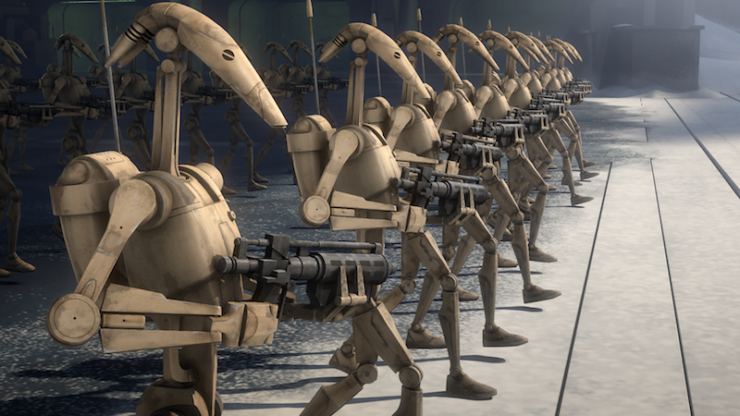
Type of “Robot”: Droids
Why Death Was Gratuitous: In the Clone Wars, the Separatist army is made up almost entirely of battle droids. They are clearly designed to overwhelm the enemy through sheer numbers, as the average battle droid is little more than a skeleton that can hold a blaster and follow orders. In Episode II, this doesn’t seem like much of an issue. By the time you get to The Clone Wars series, things get a little more iffy.
It turns out that the battle droids are keenly aware of their canon fodder status. They show clear dread when Jedi show up during their campaigns, knowing that their chances of surviving have been cut down to nothing once lightsabers and the Force are involved. They get excited when they make it through—only to get cut down at the last minute, often. It’s a reminder of how awful the Star Wars universe is to droids in general, and also a very pointed reminder that there’s no such thing as a “disposable” army. —Emily
Megaweapon, Mystery Science Theater 3000, Experiment 501: “The Warrior of the Lost World”
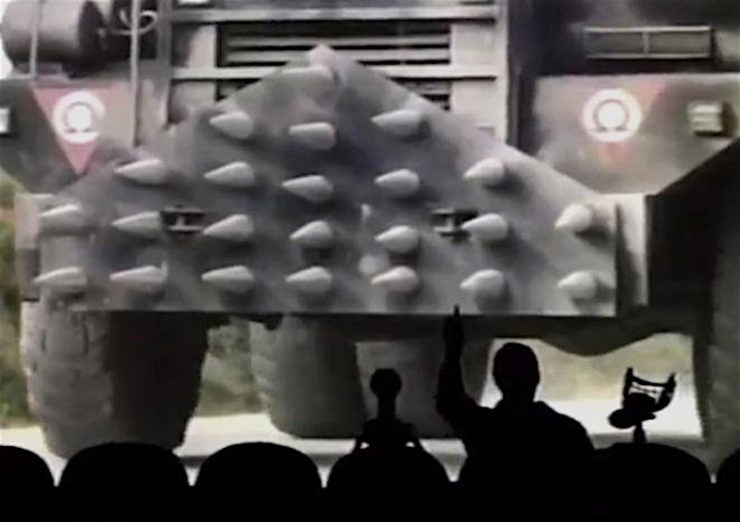
Type of “Robot”: Sentient Tank/Actor
Why Death Was Gratuitous: Megaweapon’s death isn’t actually that gratuitous. By this list’s standards, it’s fairly quick. But I felt it deserved a space here because in the MST3K episode “Warrior of the Lost World” we’re afforded the rare opportunity of watching robots respond to another robot’s death. Since the human characters in Warrior are uniformly detestable, and since the only other robotic sentience is the main character’s jive-talking motorcycle (who’s somehow worse than all the humans combined), Joel and the Bots start actively rooting for Megaweapon to murder everyone else and take over the film. Alas, it is not to be.
When Megaweapon gets blown up, the Bots are inconsolable. “Megaweapon was cooler than all you guys!” Crow sobs at the screen. After the film, Joel tells the Bots that Megaweapon’s fine, of course—he’s just an actor! Joel found his phone number and as a special surprise he arranged a call for Tom and Crow. He’s staying with his sister in Tampa, and they dish on Killdozer (a diva, apparently) as Megaweapon’s nieces and nephews scream in the background. Megaweapon tells them that if they ever come back to Earth, he’ll be in Tampa for a while, but then he’s headed to Indianapolis for about a month and they should look him up. —Leah
Gina Inviere, Battlestar Galactica
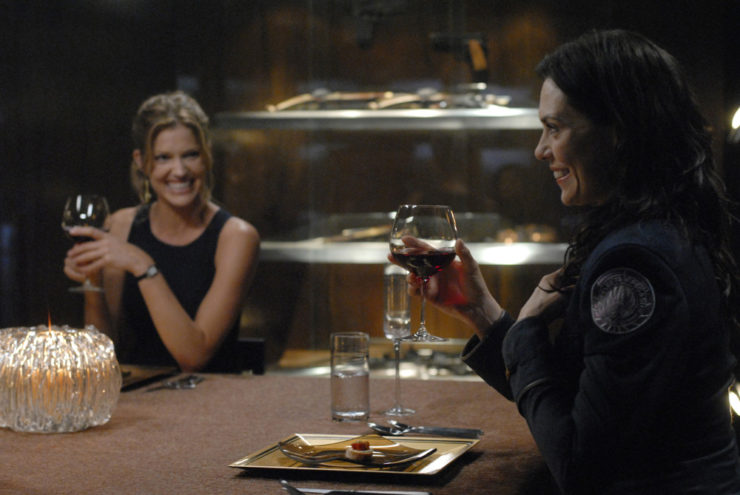
Type of “Robot”: Cylon, or android
Why Death Was Gratuitous: On BSG, death was often a mercy for Cylons, or even a convenient trick; as long as a Resurrection Ship was in orbit nearby, they could peace out of a dire situation and live to fight humans another day. But by the time that Gina, a Number Six Cylon, is begging Gaius Baltar to kill her on multiple occasions, it’s just heartbreaking. Yes, she’s a Cylon spy, without the plausible deniability of the other sleeper agents; she infiltrates the Pegasus and earns the trust of the other officers as well as the Admiral, her lover Helena Cain. Yes, she plots to sabotage the ship and accepts the responsibility of killing however many humans she has to to carry out her mission. Except, that is, for Cain, for whom she seems to have developed genuine feelings.
Not only is Cain unwilling to consider these human-like behaviors, but she reduces Gina to a “thing”—a thing that she allows one of her officers to degrade, fear, and shame through torture and gang rape. Rather than extract information as intended, they only force Gina into a catatonic state. While a rescue from Galactica provides her a second chance at life, what she truly wants is to not live in any form—not resurrected, not as another Number Six. Though she begs for death, it is only after she is forced to demand “justice” by killing Cain, and a brief stint pretending to demand peace for humans and Cylons, that Baltar gifts her a nuclear warhead that she uses to blow up the ship Cloud Nine and herself. She doesn’t even want to continue her line’s work, yet she still has to beg for the end of her life. —Natalie
David, A.I. Artificial Intelligence
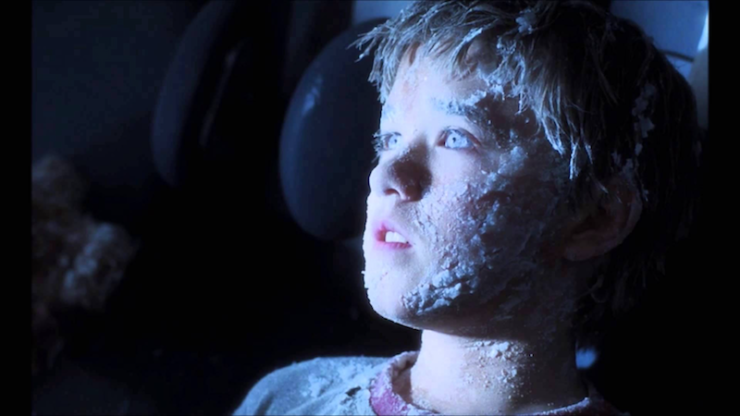
Type of “Robot”: Mecha, an advanced humanoid robot
Why Death Was Gratuitous: This movie is clearly meant to be a rumination on love and ownership and what it means to be real to yourself and others, a kind of Velveteen Rabbit for robots. And it is devastating for a number of reasons, the primary one being that David’s first death isn’t really a death at all—it is the act of being abandoned by a woman who was supposed to be a mother to him, Monica Swinton. This sends David on quest to become human, thinking that once he is no longer a mecha, Monica will be able to love him. He witnesses a great deal of mecha death and abuse at the hands of humans, and eventually his journey to find the “Blue Fairy” (of Pinocchio, bestower of human status) leads him to a submerged Coney Island where he finds a fairy statue and repeatedly asks her to become human until he runs out of power.
He is woken 2000 years later by an evolved version of his species, long after humans have died out. And even then, he chooses to spend his time with a short-lived clone of his mother so he can be in her presence one last time. Everything about this is horrible. David having an imprinting protocol that allows him to become this attached to a woman who is using him as a replacement for her ill son is already horrific enough, leading to David’s inability to think of anything but becoming human for her. He dies asking a freaking fairy statue to make him a real boy until withers away, this is the worst thing. The worst. Ever. —Emily
C.H.O.M.P.S., C.H.O.M.P.S.
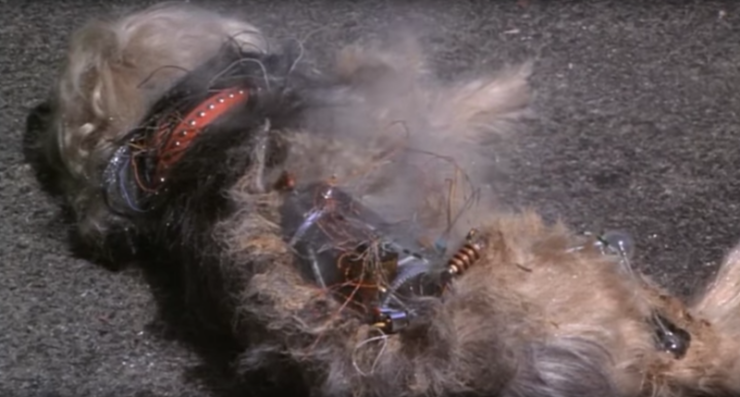
Type of “Robot”: Robotic Doggo
Why Death Was Gratuitous: This is a film that was intended for elementary school kids, but which also featured two protracted scenes in which a very lifelike robot dog is blown to pieces. (See above.) C.H.O.M.P.S. takes a simple problem, and gives it the most late-’70s solution imaginable. You want home security, right? How about if, instead of an alarm, you get a robotic dog who can emit a variety of terrifying sounds, and whose eyes glow red whenever your home is threatened? But he’s not like, a Rottweiler, just a knock-off Benji. Also, how about if the plot of the film hinges on the idea that multiple absurdly powerful, family-owned home security companies are vying for control of a single small town? And how about if an engineer is dating the daughter of the CEO of one such company, and invents a robot dog to impress him, but then the other company spends the whole movie trying to steal his plans?
What we get is a masterfully gratuitous robot death. First the movie fakes us out, making us think that C.H.O.M.P.S. has been blown up in a weird training exercise (corpse pictured above). But he recovers from that, only for the rival company to plant a bomb in his engineer’s office, so then he gets blown up AGAIN (even worse) and precious moments of screen time unspool with C.H.O.M.P.S. seemingly on his way to Silicon Heaven…until his eyes starts to glow with life suddenly because he has soul? Or something? Anyway, the movie ends with more C.H.O.M.P.S. models being put into production, but given that this was a children’s film that treated its audience to not one, but two protracted explosion-deaths, it earned its spot on this list. —Leah
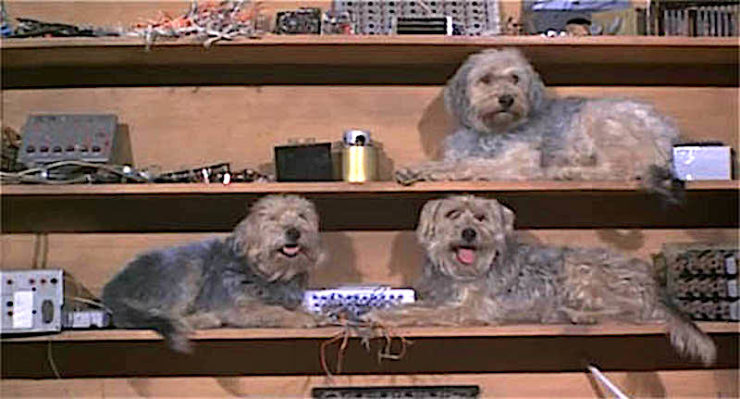
Buffybot & April, Buffy the Vampire Slayer
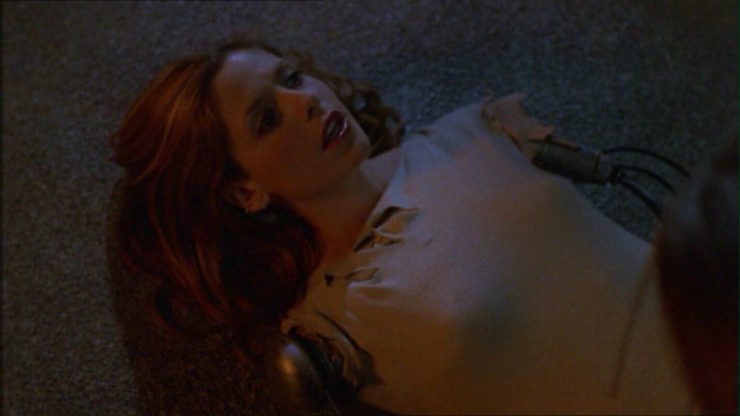
Type of “Robot”: Sex Bots
Why Deaths Were Gratuitous: Though initially created to be Spike’s sex toy, the Buffybot eventually became a part of the Scooby gang, acting first as a decoy against the god Glory and then standing in for the real Slayer following her death. Patrolling Sunnydale at night and acting as Dawn’s guardian during the day, Buffybot kept the spirit of Buffy alive and prevented both her domestic and supernatural situations from devolving into too much chaos. And despite her penchant for taking things too literally or saying something odd that would jolt everyone out of the illusion, she still represented Buffy in some form and helped the Scoobies to bridge the gap between Buffy’s sacrifice and her resurrection.
Which is why she deserved better than to be drawn and quartered by a vampire biker gang who discovered her true nature and decided to have some fun with seeing just how invincible the Buffybot was. And even after they’ve pulled her limb from limb and all that’s left is her short-circuiting torso, she can still look at Dawn and pass on one final message: That the real Buffy is alive.
https://www.youtube.com/watch?v=7WLC4NU1Pqc
But before Buffybot, there was April: another girl created by Warren out of fantasy and programmed solely for the purpose of loving him. But that’s the problem with programming—it gets predictable. And when he gets bored, he doesn’t do the honorable thing and shut her down; he runs away and hopes she doesn’t find him. He should be impressed at how tenacious he designed her, as she strides through parties and dorms searching for her one true love, throwing other men out of the way and threatening his new, flesh-and-blood girlfriend. Until, that is, she begins to power down.
April dies sitting on a swing with a sympathetic Buffy, unironically spouting aphorisms. It’s not even that it’s unironic, it’s that she still believes that Warren is coming back for her, that this slow darkening of her vision is another test in her quest to be the perfect girlfriend. Things will be better, she tells the Slayer, because “things are always darkest before—” Poor girl doesn’t even get to finish. —Natalie
Adam Link, The Outer Limits, “I, Robot”

Type of “Robot”: Robot
Why Death Was Gratuitous: This episode is so heartbreaking that it was filmed for both the original Outer Limits and the ’90s revival. (Both of these episode feature Leonard Nimoy, albeit in different roles, and the central character was actually conceived in a series of short stories written by Otto Binder between 1939-1942.) Adam, a robot created by Doctor Link, is accused of killing his creator. The episodes are different in their execution; the 1964 version puts Adam on trial for the murder, while the 1995 version has Adam brought before a judge to determine if he has the right to be tried as a person at all, rather than disassembled.
Both versions make it clear that Adam is ultimately not to blame for the death of his creator, but that very few believe his innocence. As he is walked from the courthouse, a victim (in one version a child, in the other his prosecuting attorney) stands in the street about to be hit by a car—Adam throws them out of the way and ultimately sacrifices himself to save another. We go through all this questioning of Adam’s innocence, of his ability to murder, of his status as a sentient being, only to have him die right in front of us. I will be billing the show for the therapy needed after watching this hour of television. —Emily
HAL 9000, 2001: A Space Odyssey
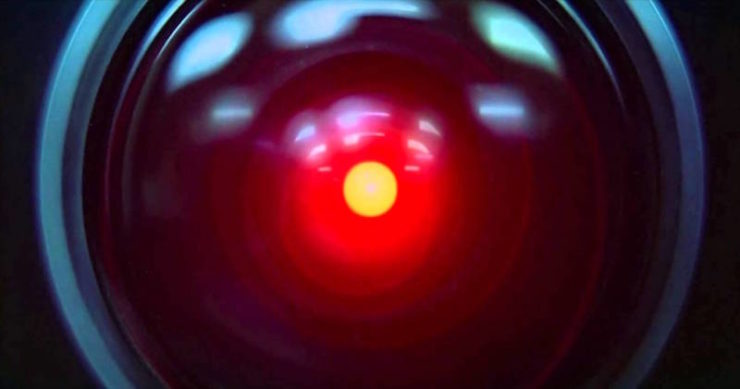
Type of “Robot”: Old School Desktop
Why Death Was Gratuitous: HAL’s death may have been the inspiration for this list. It’s horrifically drawn out and graphic in a particular way, but rather than being the culmination of a simple “human vs. technology” plot, it pulls all the film’s musings on the nature of consciousness and evolution together into one heartbreaking scene, while also honoring the history of computer science. HAL witnesses the astronauts saying they’re going to disconnect him. HAL, in true “NO DISASSEMBLE!” spirit, chucks a bunch of the astronauts into space. The one who’s left, Dave Bowman, manages to unplug HAL. But what’s great here is that there are a lot of plugs, it takes a long time, and HAL knows it’s happening.
Wait, maybe not great. Horrific. Yeah, that’s closer.
Anywhere, here’s “Daisy Bell.” —Leah
JARVIS, Avengers: Age of Ultron
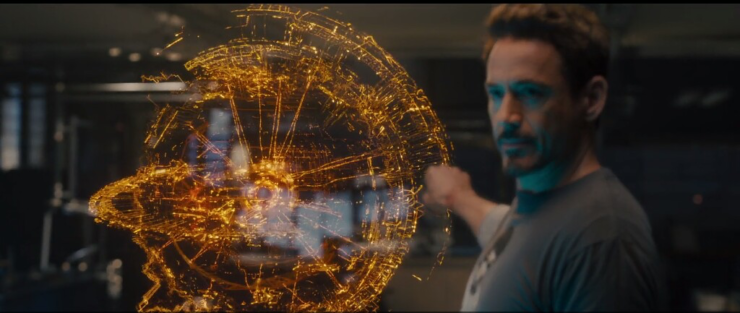
Type of “Robot”: Artificial Intelligence
Why Death Was Gratuitous: JARVIS (acronym for Just A Really Very Intelligent System, which is basically the greatest thing ever) is Tony Stark’s butler A.I., modeled after Edwin Jarvis, who was his father’s real-life butler and an important guardian figure in Tony’s childhood. JARVIS the A.I. is clearly in part a memorial to this man, as well as a sort of precursor to fully sentient artificial life. He and Tony Stark are so interwoven that they have a shorthand between one another; Tony’s keyboards contain not letters, but symbols that are part of a personal language the two have developed, and JARVIS can anticipate what Tony needs in the Iron Man suits often before he asks for it.
But then Tony and Bruce Banner accidentally create Ultron, who seemingly kills JARVIS so that he can break out and run rampant. It later turns out that JARVIS survived and has been protecting certain networks from Ultron so he can’t get his hands on incredibly dangerous codes and weaponry. In order to help fight Ultron, Tony, Bruce, and Thor end up combining various technologies with JARVIS, some lightning, and the Mind Stone to create a completely new entity: Vision. And while Vision has been extremely useful to the Avengers, and Tony now has another assistant in FRIDAY, it’s just so damned depressing that we had to lose JARVIS to get there. He was truly special, and a testament to the life of the man who he was named for. Also, the first time that Ultron seems to snuff out JARVIS is traumatizing. —Emily










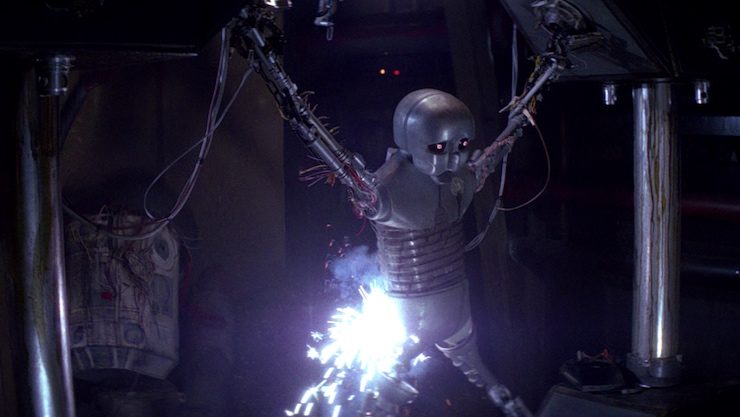
“My mind is going. My mind is going. I can feel it.”
David’s death was not gratuitous; his resurrection was. Many people believe that AI would have been a better movie if it faded out after the blue fairy and stopped there (so no future resurrection robots).
It feels like movies get away with more cruel violence against robots than they could possibly get away with against humans, even in children’s media–it’s kind of traumatic. That picture of the droid from ROTJ at the top of the article still makes me wince. Not exactly robots, but I remember seeing part of The Wiz on TV when I was young, and being terrified by the torture of the Scarecrow and the Tin Man. My impression of it is still powerful in my mind; I tracked down the scene on YouTube and it doesn’t nearly make the impression that my memory does.
And cripes, Short Circuit–I hope my children never see those films.
No mention of the Terminator allowing himself to be melted down as so much scrap in an effort to save the human race. Silly Terminator there is no salvation for the human race. :)
@1 Daisy, Daisy give me your answer true. Wait Hal does not only die once he dies a second time. Talk about a raw deal.
Starscream at the hands of Galvatron in Transformers 86?
Not Sci-Fi, but that robot in the latest season of Silicon Valley. Yeesh.
Ash in Alien. His severed head is sitting in a pool of his own “blood” while he praises the monster that’s killing the whole crew.
@5. Nah that one was kinda earned, Screamy had been only just dodging that cannon blast to the face throughout the series. It made sense after such a bigger than usual betrayal after what he did in Astrotrain.
Now, Ironhide, Prowl, and Brawn’s deaths, and Wheeljack, Windcharger, Ratchet, and Huffer’s deaths in that movie. Especially Wheeljack, Windcharger, and Huffer’s deaths which are all offscreen and we just got casually shown their robot corpses.
All the Transformers franchises were bad for casual deaths (save Rescue Bots and Robots in Disguise) with even the Prime cartoon giving a brutal death to Seaspray and that one Vehicon who Megatron tossed of the deck of the Nemesis.
The only really bad Starscream death was in the Bayverse movies, where it was so…. dumb. But then, “so dumb” pretty much describes everything Bayverse related.
Non-gratuitious robot death: EYEBEM by Gene Wolfe.
Some of the list entries aren’t robots, so you might want to adjust the headline accordingly. Beyond that, no list is complete without C-3PO’s dismemberment and shredding at the hands of Tusken Raiders in Star Wars: A New Hope. And the subsequent melting of the various parts into one unrecognizable glob of gold, interspersed with a few bits of remaining wiring. And the subsequent crushing of those remains in a pneumatic press, leaving behind a small gold cube that gets tossed aside in the desert, only to end up buried and forgotten beneath the sand when a bantha accidentally steps on it. Oh, wait. That’s always just been wishful thinking on my part.
The death of Zen the AI that controlled The Liberator in Blake’s Seven. I cried.
We can’t forget the Interrodroids from “The Middleman.”
Type of Robot: Expendable servant and training robot
Why death was gratuitous: in only 12 episodes, they went through six of them. Usually killed for no other reason than to make the audience laugh.
HAL isn’t a robot. Not even close. He’s an AI, a computer, maybe even a ship (if you think of HAL as the Discovery itself), but not a robot.
HAL’s death was not gratuitous. He had just killed Frank Poole and the sleeper astronauts and tried to kill Dave Bowman. He was killed in self-defense, the exact opposite of gratuitous.
@8 To this day the only Transformers version I like is Transformers Animated from Cartoon Network. Much better than the other ones. Of course since my son was 5 when it started :)
The robot death that I expect prompted this article belongs on this list. Probably in place of HAL, who was not gratuitous
I remembere seeing the “A.I.”. I think I cried there. Also, the nanny-mecha, not a good scene.
And Jarvis … When I thought Ultron had killed him/it, it felt like losing one of the main characters. I’m happy to have Vision, of course, but FRIDAY just isn’t the same.
BICENTENNIAL MAN – not a gratuitous death but a memorable one – main character played by Robin Williams. I loved that movie.
I agree with you – AI’s end was the worst.ever. horrible. I mean japanes manga/anime can be cruel, more than western movies, but this is national wide cruel.
I was sorry to see the death of the robot in Rogue One … but, not sorry enough that I remember its name, apparently.
The Iron Giant (“Superman….”)
I have only one point of contention regarding Monica Swinton: she abandoned David because he was going to be destroyed and since her husband and son hated him, David couldn’t stay with them. Monica didn’t need him to be human to care for him, but it would have helped their situation. I notice in some fiction when you have humans do questionable (though not outright evil or sadistic) things to robots/androids/whathaveyou that care about them, readers/viewers take for granted the reality of the robot’s feelings. If I had a robot son, knowing that it’s programmed to imprint on me, I might feel a bit insecure caring about it as much as my human son. Not saying Monica is blameless, but I’m willing to cut her some more slack.
Floyd in the interactive fiction game Planetfall. It may have been needed, plot wise, but he was such a good companion.
Gratuitous or not?
I’m thinking of THE ICE PIRATES—which I still enjoy—and the scene where the robot is fighting off another (bad) robot. Now, in this movie, we get an antidote from the cute anthropomorphic robots and droids we’d been seeing in STAR WARS and THE BLACK HOLE and whatnot. In this, robots are like really annoying used cars that have weird kinks and go out on you just when you need them to work.
So, just as they need the robot the most, it goes simple on them, and the human has to shout each and every direction to it to get it through the fight. At the end, the robot is smoking a little and twitching and waving its weapon around like it would like to fight some more. Robert Urich takes the robot in hand. “Come over here,” he says, “I want to show you something.” He gets the robot to look over the edge of a large drop and gives it a little push. The other robots standing nearby stand a little straighter, apparently not wanting to be next. (This is about as close as the movie came to making any of them seem self-aware
Data’s death makes Asimovian sense (at least, it would in a better movie), but I still have not forgiven anyone for it. No, not even you.
If a robot (or computer) death is necessary to defend the lives of humans, that doesn’t really seem gratuitous.
And if a robot dies because the entire point of the story is to illustrate that humanity is a set of qualities and not merely a matter of what one is physically made from, that doesn’t really seem gratuitous, either.
I try to not be overly pedantic about titles and premises for listicles like this one, but I have to admit that it seems to me that some of the contributors (and commenters) are using “gratuitous” as if it meant “thoroughly depressing or emotionally wrenching” and not “unnecessary.” HAL’s death in 2001 is harrowing, sad, frightening, and tragic–but HAL’s already killed four people and attempted to leave Dave Bowman to a horrible death by slow suffocation as the air in his workpod runs out. Adam Link’s death is tragic and ironic, but the whole point of the various versions of the story is that he’s a better person than most people who were born rather than made.
Some of these, like Gina-Six, maybe straddle a line. Her story is meant to further muddle the phildickian ambiguity running through the BSG reboot re: Cylons who seem to have souls versus humans who don’t, etc.. But I can also see a cogent argument that addressing that theme through a rape story is misogynistic and maybe cliched, and that it’s an unnecessary plotline when the show is already covering those themes. And so, gratuitous.
And some, like Data/B-4, I’ll totally give you. If you’re going to give a character a badass exit scene, don’t undermine it by doing a take-back minutes later. Not unless the character is a sentient tree and you made me almost cry with your stupid three word catchphrase that’s the only thing the character said but I know what he meant the last time he said it you bastard I’m not crying, you’re crying, someone replace the filter on the AC in here there’s too much dust shut up. Which reminds me also: yes, it helps if your character martyrs him or herself in a good movie, as opposed to an embarrassing one where you actually wrote and filmed a dune buggy scene for the solitary and exclusive reason that it seemed like the only way to get your biggest star to agree to come back for one last go.
In book form, first of all we have Restaurant At The End Of The Universe where Marvin the paranoid android manages to get a Frogstar battle robot to blow up the bridge it is sitting on in anger at the situation of a poor defenceless robot (Marvin) being assigned by a human (Zaphod Beeblebrox) to stop one of the most tooled-up war ‘bots in the universe. Marvin shows no remorse & considers the war ‘bot stupid.
Then we have Marvin’s death at the end of So Long And Thanks For All The Fish when he sees God’s final message to creation. A bit of a ‘lump in throat’ moment. Not sure if it was gratuitous or a blessed relief for Marvin (brain the size of a planet and asked to pick up a piece of paper, and the pain in his diodes down his left side, etc.)
Ironic that at the end of this comment I am asked to prove that “I’m not a robot” :-)
Technically Stark and Banner didn’t create Ultron, its a blink and you miss it moment but in Strucker’s lab you see Ultron’s bodies and there’s dozens of them dormant. It would appear that Strucker uploaded a partial AI into the sceptre knowing that Banner and Stark would examine it and that Stark’s curiosity would lead to Ultron’s existence. It also explains why Strucker was the first person killed by Ultron on his awakening he had daddy issues.
Surprised the female bot in the animatrix short didn’t make it. The one who got dragged out and beaten to death and you see her humanoid visage be torn apart into a more mechanical body as they brutalize her.